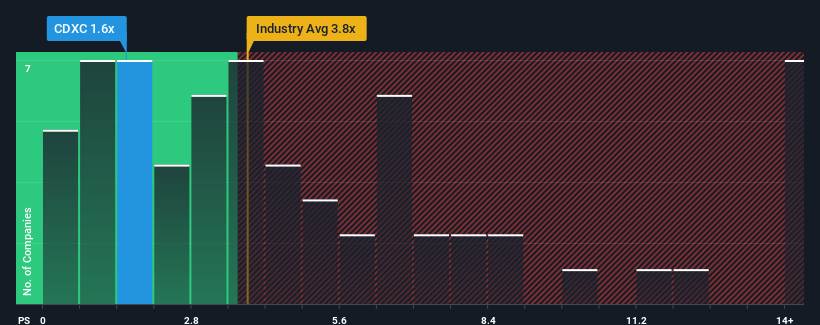- United States
- /
- Life Sciences
- /
- NasdaqCM:NAGE
Not Many Are Piling Into ChromaDex Corporation (NASDAQ:CDXC) Just Yet
ChromaDex Corporation's (NASDAQ:CDXC) price-to-sales (or "P/S") ratio of 1.6x might make it look like a strong buy right now compared to the Life Sciences industry in the United States, where around half of the companies have P/S ratios above 3.8x and even P/S above 7x are quite common. Nonetheless, we'd need to dig a little deeper to determine if there is a rational basis for the highly reduced P/S.
View our latest analysis for ChromaDex

How ChromaDex Has Been Performing
Recent times have been pleasing for ChromaDex as its revenue has risen in spite of the industry's average revenue going into reverse. It might be that many expect the strong revenue performance to degrade substantially, possibly more than the industry, which has repressed the P/S. If you like the company, you'd be hoping this isn't the case so that you could potentially pick up some stock while it's out of favour.
Want the full picture on analyst estimates for the company? Then our free report on ChromaDex will help you uncover what's on the horizon.How Is ChromaDex's Revenue Growth Trending?
In order to justify its P/S ratio, ChromaDex would need to produce anemic growth that's substantially trailing the industry.
Taking a look back first, we see that the company grew revenue by an impressive 21% last year. The latest three year period has also seen an excellent 47% overall rise in revenue, aided by its short-term performance. Therefore, it's fair to say the revenue growth recently has been superb for the company.
Shifting to the future, estimates from the four analysts covering the company suggest revenue should grow by 11% over the next year. Meanwhile, the rest of the industry is forecast to only expand by 2.1%, which is noticeably less attractive.
In light of this, it's peculiar that ChromaDex's P/S sits below the majority of other companies. It looks like most investors are not convinced at all that the company can achieve future growth expectations.
The Key Takeaway
Generally, our preference is to limit the use of the price-to-sales ratio to establishing what the market thinks about the overall health of a company.
To us, it seems ChromaDex currently trades on a significantly depressed P/S given its forecasted revenue growth is higher than the rest of its industry. When we see strong growth forecasts like this, we can only assume potential risks are what might be placing significant pressure on the P/S ratio. It appears the market could be anticipating revenue instability, because these conditions should normally provide a boost to the share price.
A lot of potential risks can sit within a company's balance sheet. Take a look at our free balance sheet analysis for ChromaDex with six simple checks on some of these key factors.
Of course, profitable companies with a history of great earnings growth are generally safer bets. So you may wish to see this free collection of other companies that have reasonable P/E ratios and have grown earnings strongly.
Valuation is complex, but we're here to simplify it.
Discover if Niagen Bioscience might be undervalued or overvalued with our detailed analysis, featuring fair value estimates, potential risks, dividends, insider trades, and its financial condition.
Access Free AnalysisHave feedback on this article? Concerned about the content? Get in touch with us directly. Alternatively, email editorial-team (at) simplywallst.com.
This article by Simply Wall St is general in nature. We provide commentary based on historical data and analyst forecasts only using an unbiased methodology and our articles are not intended to be financial advice. It does not constitute a recommendation to buy or sell any stock, and does not take account of your objectives, or your financial situation. We aim to bring you long-term focused analysis driven by fundamental data. Note that our analysis may not factor in the latest price-sensitive company announcements or qualitative material. Simply Wall St has no position in any stocks mentioned.
About NasdaqCM:NAGE
Niagen Bioscience
Operates as a bioscience company engages in developing healthy aging products.
Outstanding track record with flawless balance sheet.
Similar Companies
Market Insights
Community Narratives


Recently Updated Narratives

Proximus: The State-Backed Backup Plan with 7% Gross Yield and 15% Currency Upside.

CEO: We are winners in the long term in the AI world

Early mover in a fast growing industry. Likely to experience share price volatility as they scale
Popular Narratives


MicroVision will explode future revenue by 380.37% with a vision towards success


The company that turned a verb into a global necessity and basically runs the modern internet, digital ads, smartphones, maps, and AI.



